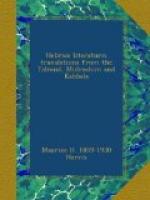Sanhedrin, fol. 42, col. 2; fol. 49, col. 2; fol. 52, cols. 1, 2.
The above, which has been
translated almost literally from the
Talmud, may serve to remove
many misconceptions now current as
to the modes of capital punishment
that obtained in Jewry.
In further illustration of this topic, we will append some of the legal decisions that are recorded in the Talmud, authenticating each by reference to folio and column. Examples might be multiplied by the score, but a sufficient number will be quoted to give a fair idea of Rabbinic jurisprudence.
If one who intends to kill a beast (accidentally) kill a man; or if, purposing to kill a Gentile, he slay an Israelite; or if he destroy a foetus in mistake for an embryo, he shall be free; i.e., not guilty.
Ibid., fol. 78, col. 2.
He who has been flogged and exposes himself again to the same punishment is to be shut up in a narrow cell, in which he can only stand upright, and be fed with barley till he burst.
Ibid., fol. 81, col. 2.
If one commits murder, and there is not sufficient legal evidence, he is to be shut up in a narrow cell and fed with “the bread of adversity and the water of affliction” (Isa. xxx. 20). They give him this diet till his bowels shrink, and then he is fed with barley till (as it swells in his bowels) his intestines burst.
Ibid.
A woman who is doomed, being enceinte, to suffer the extreme penalty of the law, is first beaten, about the womb, lest a mishap occur at the execution.
Erachin, fol. 7, col. 1.
If a woman who has vowed the vow of a Nazarite drink wine or defile herself by contact with a dead body (see Num. vi. 2-6), she is to undergo the punishment of forty stripes.
Nazir, fol. 23, col. 1.
The Rabbis teach that when the woman has to be flogged, the man has only to bring a sacrifice; and that if she is not to be flogged, the man is not required to bring a sacrifice. (This is in reference to Lev. xix. 20, 21.)
Kerithoth, fol. 11, col. 1.
Rav Yehudah says, “He that eats a certain aquatic insect, the swallowing of which while drinking would involve no penalty whatever—Tosefoth, receives forty stripes save one (the penalty for transgressing the negative precepts), for it belongs to the class of ’creeping things that do creep upon the earth’ (Lev. xi. 29).” Rav Yehudah once gave a practical exemplification of this ruling of his.
Abaii says, “He that eats a particular animalcule found in stagnant water, receives four times forty stripes save one. For eating an ant this penalty is five times repeated, and for eating a wasp it is inflicted six times.”
Maccoth, fol. 16, col. 2.
When one is ordered to construct a booth, or to prepare a palm-branch for the Feast of Tabernacles, or to make fringes, and does not do so, he is to be flogged till his soul comes out of him.




